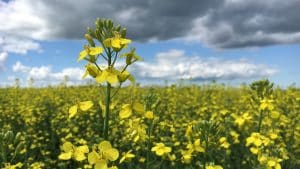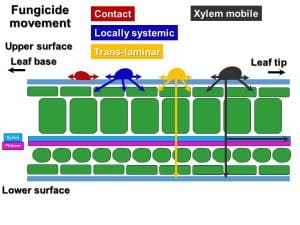Fungicide to prevent sclerotinia stem rot goes on between 20 and 50 per cent flower, with optimum timing usually closer to 20 per cent.
In Fungicide application basics, Sprayers 101 says the two top considerations for effective fungicide applications, in general, are timing and water volume.

Timing
Apply within the spray window of 20 to 50 per cent flower. The early opportunity, at 20 per cent flower, usually provides a higher economic return – if moisture conditions favour infection.
How to assess the bloom stage. Generally, it takes a crop four to five days to move from first flower to 20 per cent bloom.
Fungicide applied at the beginning of the label window will coat the petals that are there, and provide important coverage down in the canopy.
Earlier-than-label applications that target buds before they open to form flowers provides minimal benefit given the limited systemic action of the fungicides available for canola. They would not typically penetrate from the green sepal tissue into the petal tissue itself.
Coverage
Fungicide should cover as many petals as possible.
Water volume at label-recommended amounts improves coverage of flower petals and penetration down into the canopy.
Fungicide that also hits leaves, leaf bases and leaf axils – where infested petals clump – can enhance protection. Higher water volumes improve penetration and coverage of these canopy targets.
Fungicide duration
Fungicide protection in the canopy can last two weeks or more. Flower petals have a six-day life cycle. If you were to focus on applying fungicide on petals themselves you would need to repeatedly apply fungicide to coat each successive crop of newly emerged flower and petals.
The actual length of fungicide protection will depend on the product and its persistence, as well as the quality of application and its penetration into the canopy. For second fungicide applications, the recommendation is to wait seven to 14 days after the first application.
Fungicide mode of action
Most fungicides available for canola are locally systemic – they only penetrate into the outside layers of the plant tissue applied to. Some do move a bit more extensively, such as from one side of a leaf to another, or even from the centre of a leaf to the tip. (See the illustration at the bottom.)
Some fungicides are more lipophylic than others. This “love of fats” might be more advantageous than systemic activity. Lipophylic fungicides will bind to the waxy cuticle, keeping the active ingredient on the leaves and fighting the disease.
Fungicides for sclerotinia stem rot in canola
Sprayer nozzles
Nozzle choice is less important for sclerotinia stem rot fungicides. Research at AAFC Saskatoon (Kutcher and Wolf, 2001) compared five methods of fungicide application over three years to determine the effect of nozzle type and pressure on sclerotinia stem rot infection of canola and crop yield.
Variation in product performance among years indicated that environmental conditions had a major effect on crop development, sclerotinia stem rot infection, the effect of fungicides and subsequent yield.
Overall, conventional flat fan nozzles (TeeJet XR), low-drift venturi nozzles (CFFC TurboDrop) and hollow cone nozzles (TeeJet TXVS-8) were all effective at reducing disease symptoms. Both 275 and 550 kPa (40 and 80 psi) provided similar performance, although increasing the venturi nozzle pressure to 550 kPa (80 psi) improved disease control slightly.
These results indicate that venturi nozzle technology is appropriate for use with foliar fungicides for sclerotinia control in canola provided pressures are adjusted to optimize nozzle performance.
Research shows minimal effect from droplet size. Sprayers 101 makes this statement: “Work at AAFC in Melfort compared conventional and low-drift sprays at two pressures, and showed that droplet size had no effect on disease control. In fact, the fine spray produced by hollow cone nozzles at high pressure did not significantly improve sclerotinia control compared to a venturi nozzle at its recommended pressure of about 60 psi.”
Aerial application
Many fungicides allow for aerial application. Sprayers 101 notes that an aircraft’s chief advantage is to cover large areas with no crop trampling, and can do so even in wet conditions. As a result, they offer the timing advantage that is so important.
Sprayers 101 expands on the aerial option: Aircraft, out of practical necessity, apply less water and distribute it in finer sprays to offer the required coverage. Although this has been shown to be effective, it creates drift and evaporation potential. It is worthwhile to ask for higher water volumes if it means that the spray can be applied somewhat coarser, creating less drift.
Ideal weather for spraying
Hot conditions can increase evaporation of the spray, reducing its performance. Some companies say to avoid spraying in temperatures above 25-27°C.
Coarse spray droplets, in this case, will help to reduce rapid droplet evaporation while still maintaining very good target coverage.
Rainfastness varies by product. Some can be applied as little as 30 minutes before a rain. Others are recommended to have at least three hours before a rain. Also use the appropriate nozzle filter screens to improve fungicide performance. Ask the retail or check labels for specific notes on filter screens.
*Thanks to Kelly Turkington, plant pathologisit with AAFC, for help with this article.
More…
- Canola Encyclopedia section on sclerotinia stem rot management.
- Factors in the sclerotinia spray decision


